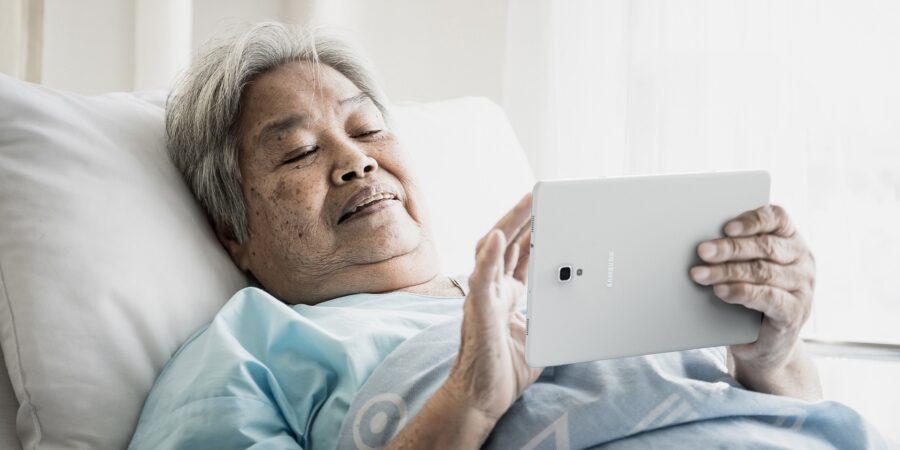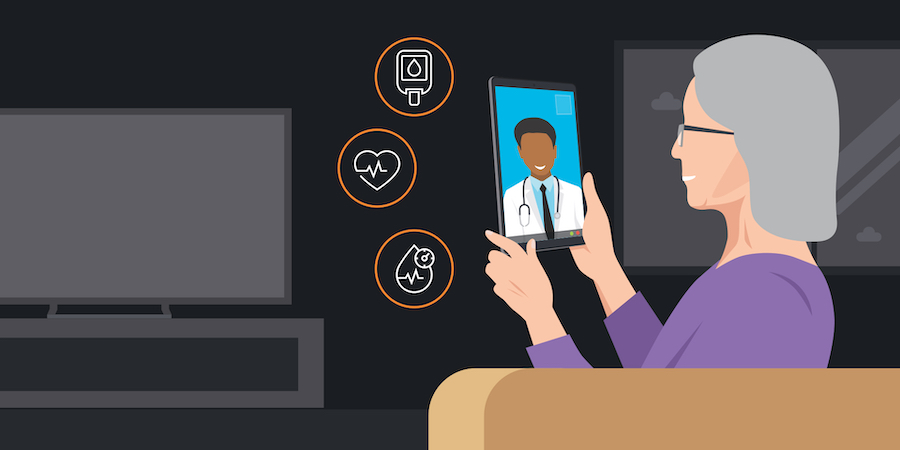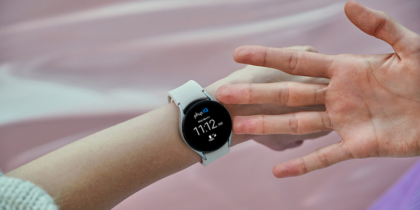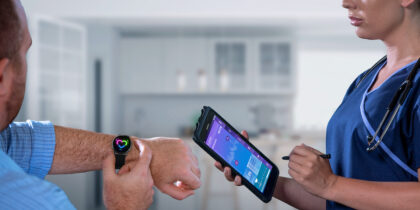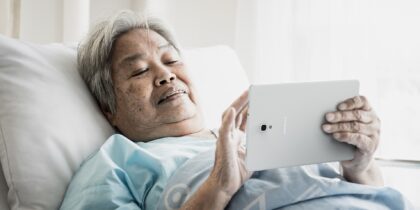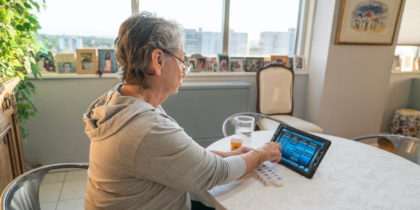Over the past decade, many industries have embraced digital transformation, using new technology to optimize their workflows, integrate data and improve the customer experience. In the last two years, healthcare has been forced to catch up, adopting virtual care solutions such as remote patient monitoring (RPM) and telehealth.
Fortunately, the technology was ready for them when they needed it most. RPM vendors like Health Recovery Solutions (HRS) have spent the last decade building robust, AI-enhanced virtual care solutions that improve the quality of care, reduce readmissions and let patients connect with their providers from anywhere. HRS delivers their highly customizable platform via Samsung tablets.
So how has telehealth evolved during the pandemic? What are the current trends, and what comes next? That’s what we asked Florence Kariuki, chief clinical officer at HRS, and Hon Pak, M.D., chief medical officer at Samsung Electronics and a practicing dermatologist.
Telehealth adoption skyrocketed during COVID-19. How has the telehealth landscape changed, and will this growth continue beyond the pandemic?
Florence Kariuki: There is no question that telehealth has exploded in the last year or so as more and more providers were forced to look at alternative ways to deliver care virtually. Prior to the pandemic, some providers were using telehealth in different, limited capacities, but COVID accelerated both provider readiness level and consumer comfort level. With the HRS platform, we’ve seen growth in health plan, hospital and post acute providers’ use of telehealth, as well as growth in patient engagement, adherence and access.
Prior to COVID-19, there was very little, if any, reimbursement for telehealth. During the pandemic, the Centers for Medicare & Medicaid Services (CMS) created specific Current Procedural Terminology (CPT) codes that cover the cost of virtual care, therefore opening up the opportunities for more providers and patients to utilize those services. More recently, CMS added Remote Therapeutic Monitoring codes that further expand reimbursement opportunities. More commercial payers have also started building virtual care into their digital health strategy and benefit plans. I expect to continue seeing more payers covering telehealth services, and a continued increase in both virtual and in-person modalities becoming the standard of care.
Hon Pak, M.D.: I agree. Consumerization and telemedicine have finally met, and there’s no going back. I had the fortune and honor of being one of the pioneers of telemedicine. For years, we did research studies and lobbied lawmakers, educating them on the benefits. It took a pandemic to finally make that change, but consumers now expect telehealth to be part of their care. Consumers, especially younger generations, are living an on-demand culture, and healthcare is finally catching up to the digital transformation that we’ve seen in other industries. Going forward, healthcare systems will be looking to create hybrid models of care that blend telehealth in with traditional services. It’s not just about adding in virtual services. When implemented correctly, telehealth should actually change the business practice by letting providers reallocate scarce resources across the health system.
How has the shift to patient-centric, value-based care contributed to the growth of virtual care?
FK: Prior to joining HRS, I worked for a large health plan leading our value-based care programs. Much of the opportunity for our providers revolved around applying appropriate interventions that help achieve the “Triple Aim” goals of value-based care: keeping costs down, improving quality of care and ensuring high patient satisfaction. Telehealth and RPM give providers a powerful tool in their arsenal to improve patient engagement and adherence to self-care, and the ability to care for high opportunity patients between in-person visits. It allows for customized patient education and insights on where the patient may need additional support. There are also opportunities to connect patients with specialists, make referrals virtually and use lower-level clinicians to monitor patients or follow up with them. All of these interventions improve patient care and outcomes, making for successful performance in value-based programs.
HP: In recent years, healthcare has begun to shift from the hospitals to ambulatory clinics, and now into the home. As this trend accelerates, it’s forcing healthcare systems to rethink what should be done in hospitals versus lower-cost outpatient settings, and what can be done in the home — whether that’s home infusions, remote monitoring or wellness. The really innovative health systems are not just building new hospitals; they’re thinking about centers of excellence and then integrating virtual care services to recruit and attract both talent and patients. Essentially, where the patients are is where hospitals are moving to, and virtual care enables that patient-centric experience while cutting costs.
The United States is experiencing a critical nursing shortage that is expected to continue through 2030. How is virtual health helping providers adapt to this challenge?
FK: The nursing shortage started well before COVID-19 and unfortunately has worsened during the pandemic. With many nurses leaving their career in the midst of the “Great Resignation,” we’re seeing health facilities either closing down or unable to take patients. If you have fewer nurses but the same or greater volume of patients, there is a need for creativity in how care is delivered, and technology can help. A good example is the ED Triage and Diversion program that HRS has implemented with our clients. Hospitals are able to leverage our RPM solutions to provide care for some COVID patients in their homes, rather than needing to admit them. HRS is also working with home health agencies to leverage our solutions in revamping their protocols for in-person versus virtual visits. This enables the use of a smaller staffing capacity, as appropriate care is shifted from in-person to virtual.
HP: What technology really enables is workforce optimization. The idea is to elevate nurses to perform at their highest state of license by relieving them of tasks that could be done by lower-cost staff or by patients themselves. This includes providing hospital patients with bedside tablets to access disease-specific education, order meals and request services, and do their own patient-reported outcomes. Mount Sinai Health System in New York has been using Samsung devices for its bedside tablet program for two years, and they’ve seen a significant reduction in the amount of time nurses are spending on data entry and paperwork, while improving patient satisfaction scores. Telehealth technologies also help redistribute nurse workloads by letting hospitals bring in retired or part-time nurses, along with care navigators, and letting them work virtually to back up on-staff nurses. For nurses who work in person, providing them with mobility solutions that combine and automate various tasks into one device — whether it’s clinical communications, barcode administration or charting — also boosts productivity.
What other industry-wide challenges can virtual care help to solve?
FK: One major challenge is limited access to care, particularly for patients who experience other social determinants of health barriers. Technology offers the ability for patients who are rurally located to access providers, and helps providers better connect with patients that would typically miss appointments. Another challenge is patient engagement and adherence to care plans. With RPM and telehealth, providers can engage patients in a setting that is convenient for them at a time that works for them. As patients monitor their own progress, they are even more likely to adhere to the plan of care that leads to improved health outcomes. Lastly, virtual care enables patient education capabilities, addressing some health literacy barriers. Using the tablets, providers can curate videos for specific patients or patient populations, then track whether patients are watching and understanding the videos through teach-back surveys.
How to build a successful RPM program
Discover solutions and best practices that transform patient experience and improve health outcomes. Download Now
HP: The engagement piece is really key. As a physician, I’m always humbled by the impact that we actually have on a given patient. Even if our diagnosis is 100 percent correct and our treatment is 100 percent effective, there won’t be a successful outcome if the patient can’t afford the medication or decides not to take it. This last-mile problem really comes down to not knowing our patients well enough, and not having systems in place, to personalize care. Having a holistic and personalized approach, along with well-designed care solutions, can give us the tools to better understand who each person is and deliver meaningful interventions that create sustainable change.
Historically, telehealth and RPM have been used largely in the post-acute space and for chronic disease management. What are some new use cases?
FK: We are seeing consistent growth in telehealth use cases. We are seeing growth in the acute care space with programs such as Hospital at Home and ED Diversion. Hospitals are also using virtual care for inpatients, setting up virtual command centers that serve as remotely based patient-sitters, or that leverage nurses to virtually support floor nurses with certain activities, such as monitoring vitals and lab results, calling physician referrals, and completing virtual discharge teaching. Health plans are also rolling out programs that leverage RPM and telehealth to complete health risk assessments and annual wellness visits.
HP: The use cases are limited by our imagination, to some degree. I believe the shift to the home is really the next frontier in healthcare. The future of medicine is not just managing chronic diseases but keeping people healthy, using wearables and other connected devices that help us understand how patients connect to their environment, whether it’s how they sleep in the bed or how they use different appliances or how active they are. Then we can see when an individual is not behaving normally and spot potential issues using predictive analytics. Fundamentally, I’m very excited about where things are and how they’ll evolve.
What comes next for digital health? And how does Samsung work with partners like HRS to make informed decisions about those product development efforts?
HP: Wearables and biosensors will advance in capabilities and become a very core part of how we monitor and engage patients. And hybrid care will become more seamless. Healthcare systems now have to manage traditional services along with new digital health services, and that’s a challenge because digital health is currently fragmented quite a bit. Samsung is working to better integrate this experience, to remove silos so that data is patient-centered and connected. We continue to work closely with HRS and other partners to really understand the changing needs of the market, which is at a very pivotal point as we move towards the home and understanding who patients really are, and we want to make sure that our devices and software support such changes to the marketplace. So I’m pretty excited about the future and solving all the problems we can solve.
FK: I would add that the next generation of devices and product development will need to be able to address growing concerns around data overload. As device capabilities continue to grow, clinicians are inundated with multiple data points to monitor and leverage in forming clinical decisions. Solutions that consolidate output and leverage AI to enable efficient clinical decision-making will be most attractive. Future solutions should also be able to effectively move with the patient from acute care settings to long-term care management of chronic conditions and to transmit information in formats that enable a comprehensive longitudinal patient record, easily accessible at different points in patient care.
Learn more about remote monitoring — including how it works, how it benefits healthcare providers and how to get started — with our free, comprehensive guide. Before launching your own RPM program, discover Samsung’s versatile range of virtual healthcare technologies.
